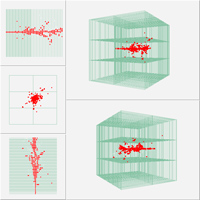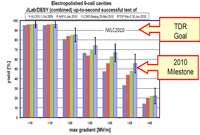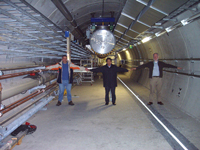First gathering in Beijing
China's domestic linear collider workshop held

Group photo of CLCW2010. Image: IHEP |
Just a week after the International Workshop on Linear Colliders (IWLC2010) held in Geneva, China's Linear Collider Workshop (CLCW2010) organised by the Institute of High Energy Physics (IHEP) was held in Beijing Laffitte Hotel from 30 to 31 October. For the first time, China's linear collider community gathered together to exchange ideas and have a comprehensive discussion about China's participation in the International Linear Collider (ILC) and the Compact Linear Collider study (CLIC). “CLCW2010, as the first one in a Chinese domestic linear collider workshop series, is a very important event for China's high energy frontier community,” said Jie Gao, chair of CLCW2010 and of ALCSC (Asian Linear Collider Steering Committee).
Read more...
-- Min Zhang |
 |
|
|
 |
| Upcoming meetings, conferences, workshops
2010 IEEE Nuclear Science Symposium and Medical Imaging Conference
Knoxville, Tennessee, USA
30 October - 6 November 2010
SiD Workshop
University of Oregon, Eugene, Oregon, USA
15-17 November 2010
X-Band Structures, Beam Dynamics and Sources Workshop (XB-10)
Cockcroft Institute, Daresbury, UK
30 November - 3 December 2010
Second Baseline Assessment Workshop (BAW-2)
SLAC
18-21 January 2011
Upcoming schools
Fifth International Accelerator School for Linear Colliders
Villars-sur-Ollon, Switzerland
25 October - 5 November 2010
US Particle Accelerator School (USPAS)
Old Dominion University, Hampton, Virginia, USA
17-28 January 2011
|
|
|
GDE Meetings calendar
View complete ILC calendar
|
|
|
 |
You say you want more resolution...

Top, side, front and three-dimensional views of DHCAL. Red sensory pads are ones that have detected a threshold energy from the pion shower. Image: Josť Repond |
Scientists led by a group at Argonne National Laboratory are bringing pictures of hadronic showers into sharper focus with the Digital Hadron Calorimeter, or DHCAL, one of several hadron calorimeter options for the ILC detector. The Argonne group began testing the device last month at the Fermilab Test Beam Facility.
Read more...
-- Leah Hesla |
 |
|
|
 |
From CERN
4 November 2010
The LHC enters a new phase
Geneva, 4 November 2010. Proton running for 2010 in the LHC at CERN came to a successful conclusion today at 08:00 CET.
Read more... |
|
From Cern Bulletin
1 November 2010
CLIC/ILC Researchers Explore New Avenues for Collaboration
Although the talks were mostly scientific and technical, the political message behind them was a breakthrough, as the workshop showed the progress made in unifying the two communities.
Read more... |
|
From Cern Bulletin
1 November 2010
Cosmic ray synergies
In laboratories, cosmic rays have been the subject of scientific research for many years. A more recent development is their appearance in schools, as educational tools.
Read more... |
|
From msnbc.com
1 November 2010
Aging U.S. particle accelerator gets more time
Fermilab's Tevatron main competitor: Large Hadron Collider in Switzerland
Read more... |
|
From New York Times
1 November 2010
Trillions of Reasons to Be Excited
...The latter suggestion raised eyebrows among physicists in and out of CERN, who wondered, among other things, what it would mean for the International Linear Collider, which has long been presumed to be the next big physics machine. ...
Read more... |
|
From Discovery News
1 November 2010
TEVATRON GETS NEW LEASE ON LIFE
The High Energy Physics Advisory Panel (HEPAP) that reports to the US Department of Energy [recommended] to extend its operation for another three years, through 2014.(...) That puts the aging Tevatron back in the game for being the first to spot the elusive Higgs boson.
Read more... |
|
|
 |
 |
|
|
 |
Cavity gradient milestone achieved

Production yields of ILC cavities, where most recent data proves that the ILC milestone of 50% yield for cavities was achieved |
One of our most visible and important ILC R&D short-term milestones has been to demonstrate production of ILC superconducting radio frequency cavities with gradient of greater than or equal to 35 megavolts per metre (MV/m) and Q0 = 8×109 and 50 percent production yield. (Q0 is the quality factor of a cavity, where a higher Q indicates a lower rate of energy loss relative to the stored energy.) Results from our cavity R&D that have recently been presented at the Baseline Assessment Workshop and at IWLC2010 are consistent with this goal, and consequently today I announce the successful achievement of that important 2010 milestone. The achievement of this gradient goal, set three years ago, is particularly noteworthy because it represents a significant step towards practically being able to produce high-gradient cavities that meet the ambitious ILC requirements.
Read more...
-- Barry Barish
Director's Corner Archive |
 |
|
|
 |
5.2 m = 3 PMs

GDE Project Managers Nick Walker, Akira Yamamoto and Marc Ross show off the width of the mock-up tunnel for the European XFEL. Image: Peter Garbincius
|
arXiv preprints
1011.0552
The flavor-changing top-charm associated productions at ILC in littlest Higgs model with T parity
1011.0337
Results from a Prototype Chicane-Based Energy Spectrometer for a Linear Collider
1011.0297
Instrumentation of the Very Forward Region at Future Linear Colliders - design and R&D by the FCAL Collaboration
1010.5992
Luminosity Measurement at the International Linear Collider
1010.5579
Simple and robust method for search Dark Matter particles and measuring their properties at ILC in various models of DM
|
|

